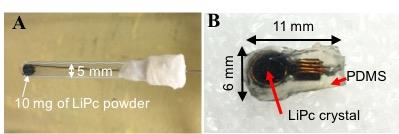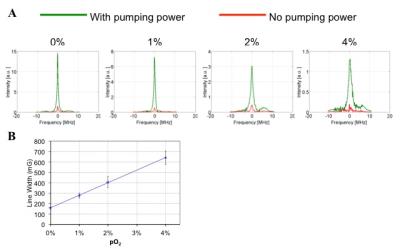2697
Enhancement of signal intensity using a wireless coil for FT-EPR oximetry study, implanted in an animal body1Radiation Biology Branch, National Cancer Institute, Bethesda, MD, United States, 2GenEpria Consulting Inc., Columbia, MD, 3National Institute of Neurological Disorders and Stroke, National Institutes of Health, Bethesda, MD, United States, 4Department of Radiology, Michigan State university, East Lansing, MI, United States
Synopsis
Improvement in sensitivity is required to detect the weak signals with Fourier transform Electron Paramagnetic Resonance (FT-EPR). In the proposed method, the signal from a wireless coil filled with sample was enhanced by using pumping coil in the regular EPR system. In this study, we achieved approximately 6-fold of improvement in signal intensity compared with conventional FT-EPR system under the simulated condition of animal body. We will also show the results of oximetry using the LiPc in, in vivo applications to measure tissue oxygenation.
Purpose
The purpose of this study is to investigate the feasibility of the signal enhancement using the wireless coil in Fourier transform electron paramagnetic resonance (FT-EPR) system for high sensitive repeated oximetry measurements. The knowledge of temporal change in partial pressure of oxygen (pO2) in tissue is important for understanding the pathology of hypoxia related diseases. The EPR oximetry is the one of the strong methods for repeated monitoring pO2 over time1,2. For repeated EPR oximetry, the signal from the reagents implanted, such as lithium phthalocyanine (LiPc)3 is so weak in the presence of oxygen. That is difficult to detect with 300 MHz FT-EPR. Therefore, improvements in sensitivity of detection is required to achieve high sensitive oximetry in 300 MHz FT-EPR. We used the wireless coil and the pumping coil in 300 MHz FT-EPR and attempted to increase the detection sensitivity of FT-EPR for EPR oximetry.Methods
A wireless coil is a detector using parametric amplification, which can amplify the weak signal by applying some power (pumping power) through the inductive coupling with external coil (pumping coil). The detailed theory and construction of the wireless coil has been reported4,5. To investigate the feasibility of using wireless coil for EPR oximetry, we verified the relation between line widths and pO2 using LiPc powder (Figure 1A). The measurements were repeated under 0, 2, 4% pO2. After the phantom experiment, we put LiPc crystals into the wireless coil and encapsulated them with polydimethylsiloxane (PDMS) which has oxygen permeability (Figure 1B). In addition, we added the circuit for adjustment of matching and tuning frequency to pumping coil for ease of in vivo measurements. To simulate the biological environment, we put the encapsulated wireless coil and LiPc, in PBS solution and used it as a sample. Figure 2C shows the configuration of the wireless amplified detection system. All spectra in this study was acquired by a homebuilt 300 MHz FT EPR6 for the all measurements in this study. The data was collected with 10 µs repletion time using less than 90º pulse power and 100000 averages. The surface coil resonator with 22 mm diameter coil was used as transmitter and receiver (Figure 2A). The quality factor of the resonator was set to around 30 to reduce dead time. The resonant frequency of the wireless coil was set to 300 MHz, and 600 MHz for pumping signal. The diameter of the pumping coil was also 22 mm (Figure 2B). The EPR measurements were repeated under the following conditions: a) with wireless coil and no pumping power; b) with wireless coil and pumping power.Results and Discussion
Figure 2 shows the results of the FT-EPR spectra with and without the pumping power when LiPc powder was used in the different pO2 condition. With the wireless coil and pumping power (-4.9 dBm), the signal intensity was enhanced approximately 6 times compared with conventional EPR detection (no pumping power). In addition, to detect the signal under 4% pO2 was possible while it was difficult to obtain the signal with conventional EPR detection. Figure 3 shows the EPR spectra of the LiPc crystal in PDMS and PBS. When the proper pumping power (in this case 12.4 dBm) was applied, taking into account of the loss of RF power in PDMS, the signal intensity was still enhanced approximately 6 times. This shows that the wireless coil in PDMS or in air have the same enhancement with appropriate pumping power.Conclusion
We have demonstrated the feasibility of enhancement of sensitivity by using the wireless coil to FT-EPR in in vivo condition. When the wireless coil was in air, the signal enhancement was approximately 6-fold. The same enhancement could be achieved in PDMS with increased pumping power. These demonstrates, the EPR measurement with wireless coil is also possible in implanted condition. We will apply this wireless coil to in vivo oximetry with more pumping power in future applications.Acknowledgements
No acknowledgement found.References
1. Matsumoto S, Espey MG, Utsumi H, Devasahayam N, Matsumoto K, Matsumoto A, Hirata H, Wink DA, Kuppusamy P, Subramanian S, Mitchell JB, Krishna MC. Dynamic Monitoring of Localized Tumor OxygenationChanges Using RF Pulsed Electron ParamagneticResonance in Conscious Mice, Magn Reson Med. 2008; 59(3): 619-625.
2. Swartz HM, Khan N, Buckey J, Comi R, Gould L, Grinberg O, HartfordA, Hopf H, Hou H, Hug E, Iwasaki A, Lesniewski P, Salikhov I, WalczakT. Clinical applications of EPR: overview and perspectives. NMR Biomed. 2004 Aug; 17(5): 335-351.
3. Ahmad R, Kuppusamy P. Theory, Instrumentation, and Applications of EPR Oximetry. Chem Rev. 2010; 110(5): 3212-3236.
4. Qian C, Murphy-Boesch J, Dodd S, Koretsky A, Sensitivity enhancement of remotely coupled NMR detectors using wirelessly powered parametric amplification. Magn Reson Med. 2012; 68(3): 989–996.
5. Qian C, Yu X, Chen DY, Dodd S, Bouraoud N, Pothayee N, Chen Y, Beeman S, Bennett K, Murphy-Boesch J, Koretsky A. Wireless Amplified Nuclear MR Detector (WAND) for High-Spatial-Resolution MR Imaging of Internal Organs: Preclinical Demonstration in a Rodent Model. Radiology. 2013; 268(1): 228–236.
6. Devasahayam N, Subramanian S, Krishna MC, A novel programmable pulse generator with nanosecond resolution for pulsed electron paramagnetic resonance applications. Rev. Sci. Instrum. 2008; 79, 026106
Figures



